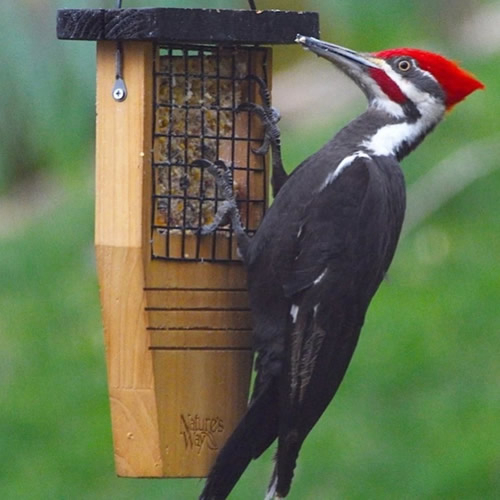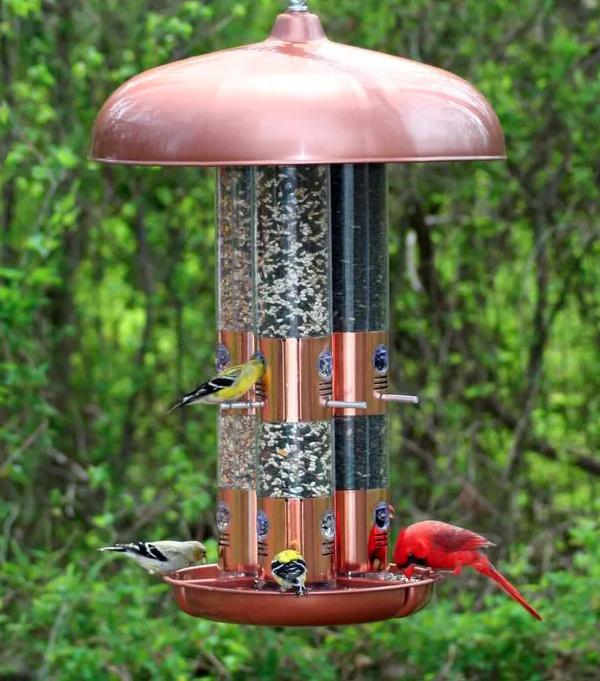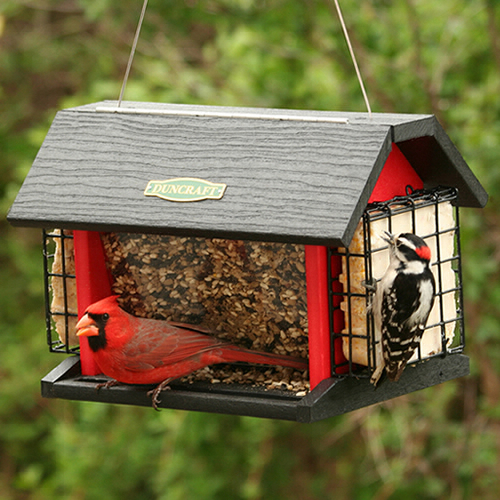
A Pileated Woodpecker uses the attached tail prop to balance as it feeds at a Duncraft Cedar Suet Tail Prop Feeder.

Rather than providing a number of feeders to offer different types of seeds, a combination feeder like the attractive Perky-Pet Triple Tube Feeder can help simplify your feeding station.

This combination feeder, the Duncraft Red Barn Cardinal Feeder, is part hopper feeder and part suet feeder. There are many options to improve, simplify, or expand your feeding station among the variety of feeder and water products available.
|
As we make the transition from summer to fall, it’s a good time to turn our attention to our feeding station, the central point of most backyard birding activities we birders enjoy. Food makes the station attractive to birds, but is it attractive to you, your family, and your neighbors? Each fall and spring, we like to take a more critical look at our feeding station and consider how we might expand or simplify elements, make visual improvements, add or match feeder colors, reconsider the positioning of feeders, and appreciate the sight lines we view bird activities from.
Most feeding stations are rather unique, based on personal preferences and choices, including what birds we wish to attract. But today, let’s start from the beginning, and consider the variety of feeders, water features, and associated gear that birders use to create and maintain a bird feeding station.
Some birders may provide a large feeding station to accommodate as many different species as possible, while others may concentrate on a providing a more focused water and food station, but it’s important to know the options at hand, and choose the elements that provide the greatest reward for you personally – and for birds that you can benefit season to season. Here we provide a list of feeders, water features, and associated equipment that are popular among birders continentwide, starting with hopper and platform feeders and working our way through a list of options.
Hopper Feeders are probably the most popular bird feeders, and they come in a variety of shapes, sizes, and colors – available for larger seeds like black oil sunflower seeds, and smaller thistle seeds, although there are a few combination feeders that are divided to provide separate compartments for both, which is a handy option. Seeds are typically added from the top of a hopper feeder and they filter down to openings at feeding perches or a platform at the bottom of the hopper.
Tube Feeders are essentially specially designed hopper feeders with feeding perches positioned along the sides rather than at the bottom. They are usually used to provide smaller seeds for smaller birds, including the variety of finches.
Suet Feeders are a standard for every feeding station, and they usually consist of a simple wire cage that holds a suet cake. Better yet are the suet feeders that include a tail prop on the lower side of the feeder, which is helpful for woodpeckers that get better balance when propping their tail against the wood or plastic extension.
Platform Feeders are used in a variety of sizes, often consisting of a simple open square of wood with a bordering rim to keep seeds from falling out. But platform feeders can also take the form of a circular ceramic or clay bowl with a surrounding rim. Platform feeders can be mounted on a post, suspended by chain or rope hangers, and they are easily accessed by birds.
Combination Feeders are available that combine the utility of a hopper feeder, or even a 2-sided hopper feeder to provide 2 types of seeds; plus a suet cage affixed to one or both ends. A combo feeder may even have a tray positioned below it that effectively acts as a platform feeder addition.
Squirrels can dominate bird feeding stations, and if that’s part of the fun for you, by all means enjoy them. But many birders prefer to squirrel-proof their feeding stations. This can be done by using baffles that prevent squirrels from climbing to feeders, or by buying individual Squirrel-proof Feeders. Some squirrel-proof feeders essentially have a cage built around the feeder, although this obstructs your view of the birds you wish to see as they visit the feeder. Better yet are squirrel-proof feeders that use a bit more technology to keep squirrels from accessing seeds, nuts, or suet.
In the Sunbelt, even during winter a Hummingbird Feeder may be a primary element of a feeding station, along with an Oriole Feeder, even though birders in the north will need to wait until late April or May for returning hummingbirds and orioles.
But wait, there’s more: Water is a most important component of any feeding station, and it can be offered in a hanging ceramic dish, or as a traditional bird bath, as simple or ornate as you wish. As colder weather approaches in many regions, there is also the option of heating your water source to keep it from icing up. And, of course, there is the potential to provide water in a decorative water feature that may include a natural spring-like trickling movement that runs into a small pool, or a fountain, or any other aquatic landscaping feature.
To organize a number of different feeders, most birders utilize Feeder Poles and Hangers. A single pole with a few hangers spaced out from on opposite sides can be a big plus when you create an ultimate feeding station. You can also install a shepard’s crook or 2 for additional hanging feeders as needed.
While most birders already have their feeding station positioned in just the right place, in case you are interested in a change or improvement, or if you are just starting out, Positioning your feeding station can be a matter of finding just the right location to view it from a preferred window or windows. Most birders like to keep their feeding station in an open location, at least 12 feet from the nearest tree, fence, or other launching pad to keep squirrels from jumping to feeders. It’s also probably best to keep your feeders positioned close to windows, less than 10 feet, so if a bird makes a mistake and flies into your window, it will not have the velocity to harm itself. Otherwise, a window treatment to keep birds from flying into windows is an option.
It’s second nature to point out that it’s important to keep your feeders Clean, and the area below and around your feeding station clean too. We prefer to feed shelled seeds and peanuts to avoid a ground-based mess.
We also like to add a couple natural Perches a few feet away from our feeding station to provide a place where birds can perch as they approach a feeder, or as they wait their turn. We simply find a sturdy branch and thrust it into the ground, attached to a metal anchor for added stability. They also provide a nice perch for you to take Photographs of the birds that visit your feeders and water feature.
Feeding birds is a most enjoyable and noble effort, and while the foods we provide are mostly supplemental, they can be important for survival at times, especially during migration stops and extended bad winter weather. Most of all, a feeding station attracts interesting birds into view, and opens the door to a wealth of bird oriented activities in your yard, your neighborhood, and beyond at birding locations near and far.
Share your backyard birding experiences and photographs with The Birding Wire at editorstbw2@gmail.com